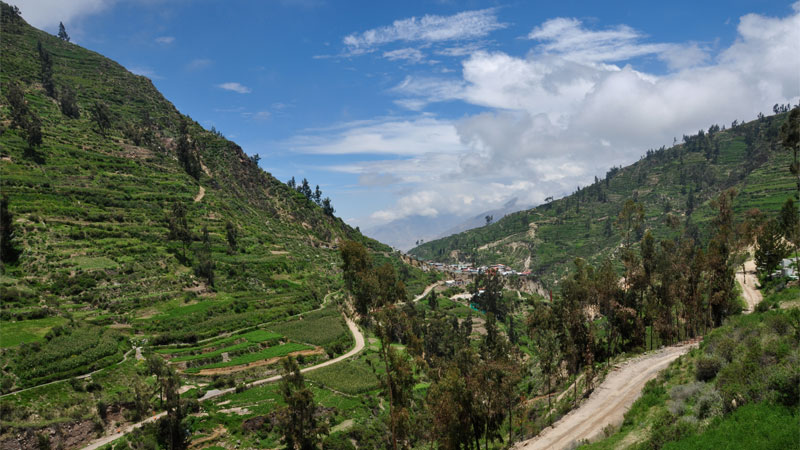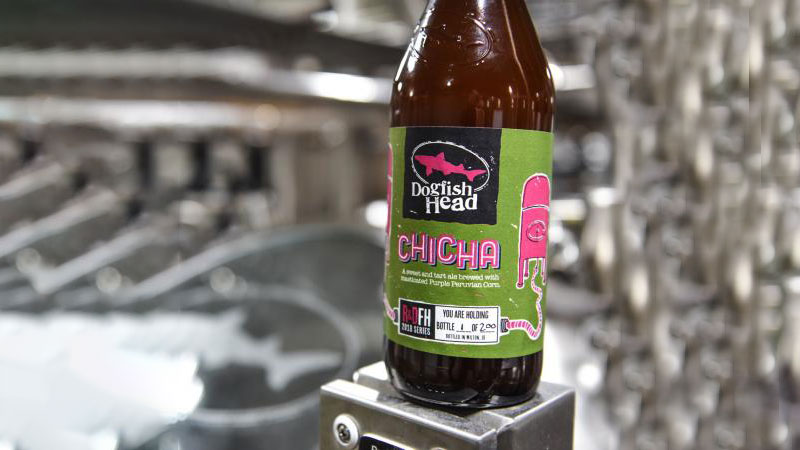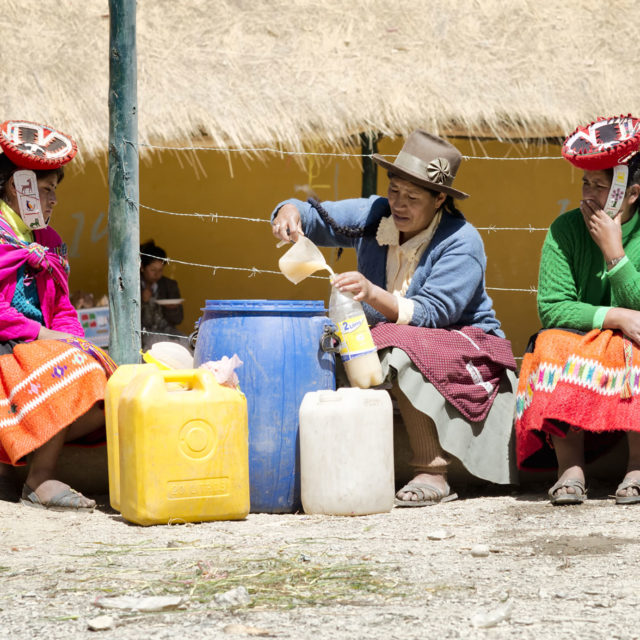Chicha de jora, or “chicha” for short, is a naturally fermented, corn-based brew originating in southern Peru. Ancient in origin, it is sold on street corners and in municipal markets today in the Andean regions of Peru and Bolivia, where vendors ply it in repurposed plastic soda bottles to go, or ladle it into pint glasses for passersby to guzzle on the sidewalk.
Chicha has long been understood to be made with masticated maiz — in other words, corn that is chewed and spit out. Because the starch in corn can’t immediately be fermented by yeast, enzymes in saliva convert starch to sugar, making it digestible for yeast, which convert the sugar to alcohol.
Craft beer aficionados may recall Dogfish Head Craft Brewery’s Chicha rendition, offering a modern take that enlists employees to chew and spit indiginous Peruvian corn. Although this is not inaccurate, and the ritual still exists today, a recent study indicates it may not be entirely true — or at least, not the whole truth.
After a years-long excavation of an ancient Peruvian brewery burned and abandoned nearly 1,000 years ago, scientists discovered evidence of a more sophisticated method previously thought to have evolved much later. Sifting through the ashes, the team of archaeologists and anthropologists found that indigenous women brewers were not chewing the corn — they were malting it.
Chicha’s Ancient, Alternate History

In April 2019, scientists from the Field Museum of Chicago, the University of North Carolina at Greensboro, the University of Illinois at Chicago, and Eastern Michigan University published a study in the journal Sustainability detailing a years-long excavation of an expansive brewing facility located on the top of Cerro Baúl, outside the modern city of Moquegua in southern Peru.
The dig took place between 1997 and 2004, and the study centered on “feasting events in the ancient Wari state (600–1000 CE),” specifically “the fabrication of ceramic serving and brewing wares for the alcoholic beverage chicha de molle.”
As part of the study, the team re-constructed a narrative of the ancient brewery, as well as a recipe that may have been used to make the ceremonial brew. They believe the 5,000-square-foot brewery regularly produced between hundreds and thousands of gallons of chicha for religious and political ceremonies that were designed to develop alliances and networks with visiting dignitaries from other Wari communities. Using cutting-edge laser technology, the team examined clay vessels and other brewery remains.
“We found sprouted corn kernels in the brewing room,” Dr. Donna J. Nash, associate professor of archaeology at the University of North Carolina, Greensboro, and a co-author of the study, says. This suggests that the Wari brewers were malting the grains.
Additionally, she says, “We don’t have evidence to prove that chewing was part of the process. When we look at skulls and teeth [of ancient skeletons], we can tell who chewed coca leaves. If there were women tasked with chewing corn, we would see it in their skulls.”
Dr. Nash’s team also found the remains of Peruvian pink peppercorns, suggesting the ingredient was used to flavor the chicha, or to brew another form of the beverage when corn was not available. “Pervuian pepper is what makes the Wari beer special,” Dr. Nash says.
(Peruvian pink peppercorn, known locally as molle, is not technically a peppercorn, but a berry, which grows on local trees year-round. Inside a pink, papery coating is a peppercorn coated with a sugary resin, used to make a honey-type sweetener called “miel de molle.”)
Resurrecting a Recipe (No Saliva Required)

Of course, data can only take science so far. Dr. Nash solicited local women in Moquegua to recreate the ancient recipe her team constructed from the remains, using replicas of the clay boiling and fermenting vessels discovered in the brewery.
It “took a while to find women who knew how to do it,” Dr. Nash says. “The knowledge is quite specific, and women who know how to do it maintain prestige in their families by not sharing that knowledge with everyone.”
Dr. Nash enlisted the leadership of a local expert — whose name she did not share — and who, while supervising the other women, would speak only in Aymara, the local language used by indigenous communities. “She wouldn’t speak in Spanish,” Dr. Nash says.
The chicha de jora resurrection began by sprouting 10 kilograms of corn in damp blankets that were placed against the wall of an agricultural terrace. Twice a day, the women poured water on top of the blankets. After several days, the corn sprouted, and was spread on the blankets to dry for several more days. Once the corn reached a certain appearance, the team ground all 10 kilos of corn into a flour-like consistency using a mesa and mortero (table and grinding stone). It took all day.
Boiling came next, as the corn flour was mixed with water to make a batter, then slowly poured into water brought to a boil in a globe-shaped clay vessel over fire. After boiling the wort for about an hour, the brewers allowed it to cool, then strained the dregs through cheesecloth into fermenting vessels with narrow necks and flared rims.
“Some archaeologists also thought the narrow vessels were for boiling, but when we tried using them for that purpose, they boiled over very quickly,” Dr. Nash says. She adds, “The local women tried to tell us this, but we insisted on experimenting and, sure enough, they were right.”
To make chicha de molle, Dr. Nash and her colleagues collected the tiny pink peppercorns from nearby trees. “The tree sap is quite sticky, and it’s difficult to tell when the berries are ripe,” Dr. Nash says. It requires a certain finesse. She recalls, “The local women had a good laugh at our expense while we picked the molle.”
With the local women’s help, Dr. Nash’s team managed to collect enough ripe molle berries to complete the brew. “They considered this batch something special, as they don’t often make it at home in general, much less in clay pots,” Dr. Nash says. At least one woman threw an early birthday party for a family member so they could enjoy the chicha fresh.
How to Homebrew Your Own Chicha
Feeling adventurous? For those who want to make their own batch of chicha de jora at home, we have developed a Crock Pot or Instant Pot-friendly recipe that takes about a week to make, from sprouting to brewing to fermentation. The corn is available at Mexican or Latin American stores, or possibly in the Mexican/Latin section of supermarkets.
The recipe that follows includes a simple process for making chicha, no spit required.
Ingredients:
- 2 cups dried maíz morada (purple corn)
- 1 gallon water
- 2 cups sugar (piloncillo or panela is best)
- 4 cinnamon sticks
- 10 cloves
- 1 lemon, peel and juice
- 1 cup pineapple peel (this has the bacteria and wild yeast that will ferment the liquid)
Making the Maiz de Jora
- Place the corn in a large bowl and cover it with water. Let it soak for a day.
- Rinse the corn, then spread onto a clean towel so the kernels are one layer deep. Roll up the towel.
- Place the towel in a large pot and add enough water to soak the towel, but not so much that water is standing in the bottom of the pot. Store at room temperature.
- After four days, unroll the towel. Most of the kernels should have sprouted rootlets that are about as long as the corn kernel, which means some of the starch has been converted to sugar. Rinse the kernels.
- Spread the kernels on a baking sheet or on tin foil and dry them in the oven on low heat until crunchy, about an hour.
Brewing the Chicha
- Put the dried corn in a blender and chop until all the kernels are broken. Alternatively, you can use a rolling pin to crush them or chop them with a knife.
- To an Instant Pot, add a gallon of water, the broken corn, sugar, spices, and lemon peel (but not the pineapple peel). Set to warm. You can also do this in a pot on the stove, but use a thermometer to keep the temperature consistently at 150 degrees for an hour. Remove from heat.
- When the liquid has cooled to room temperature, strain out the solids and add the lemon juice and pineapple peel. Put the lid back on the pot and let it rest at room temperature.
- The liquid should start fermenting in two or three days. After five days, remove the pineapple peel; the chicha should be cloudy and fermenting slightly but ready to refrigerate and drink. The longer this ferments, the stronger the alcohol level and the more sour the final chicha will be.
This story was co-authored by Scott Mansfield.
This story is a part of VP Pro, our free platform and newsletter for drinks industry professionals, covering wine, beer, liquor, and beyond. Sign up for VP Pro now!
